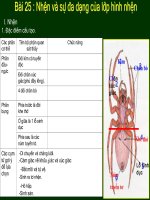Tải Giáo án tiếng Anh lớp 9 Tuần 25 sách mới - Giáo án điện tử môn tiếng Anh 9 theo tuần
Bạn đang xem bản rút gọn của tài liệu. Xem và tải ngay bản đầy đủ của tài liệu tại đây (107.87 KB, 8 trang )
<span class='text_page_counter'>(1)</span><div class='page_container' data-page=1>
<b>GIÁO ÁN TIẾNG ANH LỚP 9 </b>
<b> TUẦN 25</b>
<b>NĂM HỌC 2019 - 2020</b>
<b>Period: 16 </b> <b>Week: 25</b>
<b>UNIT 9: ENGLISH IN THE WORLD</b>
<b>PERIOD 1: GETTING STARTED </b>
<b>I. OBJECTIVES: By the end of the lesson, Ss will be able to use the lexical items </b>
related to languages and language use and learning.
<b>II . TEACHER AND STUDENTS’ PREPARATION : </b>
<b>1.Language content </b>
<b>Vocabulary : words related to languages and language use and learning</b>
<i><b>Grammar : 2.Techniques : group work , pair work, communicative approach</b></i>
3.teaching aids : Cassette, posters, pictures
<b>III. PROCEDURES: </b>
<b>T’s & Ss’ Activities</b> <b>CONTENT</b>
<b>*Warm –up </b>
review the previous unit by asking two Ss to
go to the board, each writing we compound
nouns they have learnt/ known. Give
comments and correct any mistakes if
needed.
<b>*Activity 1</b>
<b>a. Tell Ss to refer to the conversation to </b>
find the nouns of the adjectives simple and
flexible. Ask them to pay attention to how to
form the nouns from these adjectives.
<b>b. Ask Ss to convert the adjectives given into</b>
<b>1. Getting started: chatting </b>
<b>2. Listen and read </b>
Vocabulary
Nouns are often formed by adding
suffixes to adjectives. Two suffixes
which are often added to adjectives to
form nouns are -ness and -ity.
Example: open → openness
similar → similarity
<b>Exercise 1</b>
<b>a . Key: simplicity - flexibility</b>
</div>
<span class='text_page_counter'>(2)</span><div class='page_container' data-page=2>
nouns. Remind them to use a dictionary to
check.
<b>c. First, have Ss work independently. Then </b>
allow them to share answers before
discussing as a class. Call on some Ss to give
explanations for their answers.
<b>*</b>
<b> Exercise 2: Ss work independently, and then</b>
share their answers with one or more
partners. T may ask for translation of the
words/phrases in the table to check their
understanding. With a stronger class, T may
wish to ask Ss to find some examples in real
life with the words/phrases in the table.
<b> Exercise 3: Have Ss work independently </b>
and then share their answers with one or
more partners. T may help with the
words/phrases that Ss do not know the
meaning of in the sentences. If time allows,
have some Ss read out loud the sentences
<b>Adjective Noun</b>
sad sadness
dark darkness
stupid stupidity
popular popularity
happy happiness
punctual punctuality
<b>c.Key:</b>
1. B 2. C 3. A 4. C 5. B
<b>Exercise c: Answer key:</b>
Veronica wishes her parents could put
themselves in her situation to better
understand her.
<b>Exercise 2: </b>
<b>Key:</b>
1. c 2. e 3. b 4. a 5. d
<b>Exercise 3: Key:</b>
<b>Key: </b>
1. f 2. c 3. a 4. b 5. e 6. d
<b>IV- CON SOLIDATION & HOMEWORK:</b>
<b>1.Consolidation : </b>
</div>
<span class='text_page_counter'>(3)</span><div class='page_container' data-page=3>
<b>2.Homework : </b>
Do exercise in exercise book.
<i><b>Prepare A CLOSER LOOK 1 </b></i>
<b>Period: 17 </b> <b>Week: 25</b>
<b>UNIT 9 : </b> <b>ENGLISH IN THE WORLD</b>
<b>PERIOD 2 : A CLOSER LOOK 1</b>
<b>I.</b> <b>OBJECTIVES:</b> By the end of the lesson, Ss will be able to identify the
correct tones for new and known information and say sentences with the correct
intonation
<b>II. TEACHER AND STUDENTS’ PREPARATION : </b>
<b>1.Language content </b>
<b>Vocabulary : bilingual , fluent, rusty, pick up a language, reasonably, get by in a</b>
language
<i><b>Grammar : </b></i>
2.Techniques : group work , pair work, communicative approach
3.teaching aids : Cassette, posters, pictures
<b> III. PROCEDURES: </b>
<b>T’s & Ss’ Activities</b> <b>CONTENTS</b>
<b>Vocabulary</b>
<b>1 . Ss work independently and then share</b>
their answers with a partner. T may ask
for translation of the words/
phrases in the first column to check their
understanding. With a stronger class, T
may wish to ask Ss to make sentences
with the expressions.
<b>2 . a Ss do the exercise individually. </b>
Check their answers as a class. Confirm
<b>VOCABULARY:</b>
<b>Exercise 1:</b>
Key:
1. b 2. e 3. a 4. d 5. f 6. c
</div>
<span class='text_page_counter'>(4)</span><div class='page_container' data-page=4>
the correct answers.
<b>b . Ss write sentences with the phrases </b>
from 2a. Ask some Ss to say their
sentences in front of the class.
Other Ss give comments. If time allows,
call on two Ss to write their sentences on
the board. Other Ss give comments.
Confirm the correct sentences.
<b>Exercise 3:</b>
<b>3 a First, have Ss work individually to </b>
match the words/phrases. Then allow
them to share their answers before
checking with the whole class. T may
ask for translation of the phrases in the
box to check their understanding. With a
stronger class, T may wish to ask Ss to
make some example sentences with the
words/phrases.
<b>b Ss work independently to complete the </b>
passage. Check the answers as a class.
<b>Pronunciation</b>
<i><b>Tones in new and known </b></i>
<i><b>information</b></i>
<b>Key:</b>
2. at 3. by 4. in 5. of 6. bit 7. up
<b>Exercise 3: </b>
<b>Key (suggested):</b>
Key:
1. e 2. h 3. g 4. b 5. a 6. c 7. d 8. f
<b>Key: </b>
1. know 2. guess 3. look up 4. have
5. imitate 6. make 7. correct 8. translate
<b>Pronunciation: </b>
</div>
<span class='text_page_counter'>(5)</span><div class='page_container' data-page=5>
<b>4 Play the recording and ask Ss to listen </b>
and repeat the sentences, paying
attention to whether the voice on the
underlined word in each sentence goes
up or down. T may play the recording as
many times as necessary. Explain the
rule in the REMEMBER! box and ask
some Ss to give some more examples.
<b>5 Play the recording and ask Ss to listen </b>
to the conversation, paying attention to
whether the voice of each second
sentence goes up or down. Ask some Ss
to give their answers and then play the
recording again for Ss to listen, check
and repeat. T may play the recording as
many times as necessary.
6 First, ask Ss to work in pairs to
practise reading aloud the conversation
and identify whether the voice on the
underlined word in each sentence goes
up or down. Then play the recording. Ss
listen and draw suitable arrows. T may
pause after each sentence and ask them
to repeat chorally. Correct their
pronunciation if necessary.
<i><b>goes up or down</b></i>
<b>IV- CON SOLIDATION & HOMEWORK:</b>
<b>1.Consolidation : </b>
Sts practice the intonation of sentences
<b>2.Homework : </b>
</div>
<span class='text_page_counter'>(6)</span><div class='page_container' data-page=6>
<i><b>Prepare A CLOSER LOOK 2 </b></i>
<b> Period: 18 </b> <b>Week: 25</b>
<b>UNIT 9: ENGLISH IN THE WORLD</b>
<b>PERIOD 3: A CLOSER LOOK 2 </b>
<b>I. OBJECTIVES :By the end of the lesson, Ss will be able to use conditional </b>
sentences type 2 correctly and appropriately, use relative clauses correctly and
appropriately
<b>II . TEACHER AND STUDENTS’ PREPARATION : </b>
<b>1.Language content </b>
<b>Vocabulary : </b>
<i><b>Grammar : conditional sentences type 2</b></i>
relative clauses
2.Techniques : group work , pair work, communicative approach
3.teaching aids :, posters, pictures
<b>III. PROCEDURES: </b>
<b>T’s & Ss’ Activities</b> <b>CONTENTS</b>
<b>1. Grammar</b>
<i><b>Conditional sentences type 2: review</b></i>
1 a Ask Ss to study part of the
conversation. Draw Ss’ attention to how
conditional sentences type 2 are
formed and used by analysing the
underlined part of the sentence. Draw
Ss’ attention to the notes and the
examples in the Look out! box. Then
ask some more able Ss to give some
examples to illustrate.
b First, have Ss work independently,
then ask them to share their answers
with one or more partners.
Ask some Ss to say their answers aloud.
Give comments, and make any
correction if necessary.
<b>Grammar</b>
<b>Exercise 1 : </b>
<b>Key:</b>
<b>Key:</b>
<b>1. No 2. Yes 3. No 4. No 5. No</b>
Key:
1. My parents told me they would visit me
that week.
2. Our teacher asked us what we were most
worried about.
3. Phuong told me she was so delighted
because she had just received a surprise
birthday present from her sister.
4. Tom said Kate could keep calm even
when she had lots of pressure.
</div>
<span class='text_page_counter'>(7)</span><div class='page_container' data-page=7>
<b>2 . Have Ss work independently to write </b>
the sentences. If there isn’t much time or
Ss are not so strong,
allocate one or two sentences per
student. Then ask them to share their
answers with a partner.
Ask some Ss to write their sentences on
the board and discuss as a class. Give
comments and make any
corrections.
<i><b>3 . Relative clauses</b></i>
<b>3 a Ask Ss to read part of the </b>
conversation from GETTING
STARTED, paying attention to the
underlined clause. Then have Ss read the
REMEMBER! box and explain to Ss the
words that are used to introduce a
relative clause. Ask Ss to make some
examples to illustrate.
<b>b Ask Ss to study the rules in the </b>
grammar box. Draw Ss’ attention to the
use of relative clauses by analysing
the examples in the grammar box in 3b.
<b>4 Ask Ss to do the exercise individually.</b>
Remind them to look back to the
high score in her last test.
6. The doctor asked him if he slept at least
eight hours a day.
<b>Exercise 2: </b>
<b>Key:</b>
1. If my English were/was good, I would
feel con dent at interviews.
2. If Minh had time, she would read many
English books.
3. If I were you, I would spend more time
improving my pronunciation.
4. If Mai didn’t have some friends who
were/are native speakers of English, she
wouldn’t be so good at the language.
5. If you could speak English, we would
offer you the job.
<b>Exercise 3: </b>
</div>
<span class='text_page_counter'>(8)</span><div class='page_container' data-page=8>
REMEMBER! box and the grammar
box in 3b. Then have Ss compare their
answers in pairs before checking with
the whole class.
<b> 6 Before allowing Ss to do Exercise 6, </b>
ask them to study the rules in the Look
out! box. Then have Ss work
independently. Ask them to share their
answers with a partner. Ask some Ss to
say their answers aloud.
Give comments, and make any
corrections.
1. who/that 2. where 3. whose 4.
when/that 5. whom/who 6. why
<b> 6. Key:</b>
2. Parts of the palace where/in which the
queen lives are open to the public.
3. English has borrowed many words
which/that come from other languages.
4. I moved to a new school where/in which
English is taught by native teachers.
5. There are several reasons why I don’t
like English.
6. The new girl in our class, whose name is
Mi, is reasonably good at English.
<b>IV- CON SOLIDATION & HOMEWORK:</b>
<b>1.Consolidation : Have Ss work independently, writing true sentences about </b>
themselves. Then ask them to share their sentences with one or more partners to
find out how many things they have in common.
<b>2.Homework : </b>
Do exercise in workbook.
<i><b>Prepare COMMUNICATION</b></i>
Mời bạn đọc tham khảo thêm tài liệu Tiếng Anh lớp 9 tại đây:
Bài tập Tiếng Anh lớp 9 theo từng Unit:
Bài tập Tiếng Anh lớp 9 nâng cao:
</div>
<!--links-->









